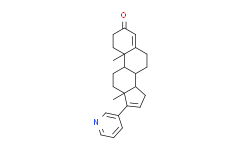| Description: |
D4-abiraterone is a major metabolite of abiraterone. D4-abiraterone is an inhibitor of CYP17A1, 3b-hydroxysteroid dehydrogenase (3βHSD) and steroid-5a-reductase (SRD5A) and also an antagonist of androgen receptor. |
| Target: |
CYP17A1, 3βHSD, SRD5A, androgen receptor[1] |
| In Vivo: |
D4-abiraterone (D4A) is tenfold more potent than abiraterone (Abi) in blocking conversion from dehydroepiandrosterone (DHEA) by 3β-hydroxysteroid dehydrogenase (3βHSD) to D4-androstenedione (AD) in LNCaP and VCaP xenografts. 0.1 μM D4-abiraterone is equivalent to 1 μM Abi for blocking AD accumulation at 48 h in both LNCaP and VCaP xenografts. Progression is significantly delayed in the D4-abiraterone group compare with the Abi acetate group (P=0.011). D4-abiraterone treatment increases progression-free survival compare with Abi acetate[1]. |
| In Vitro: |
D4-abiraterone (D4A ) (10 mM) nearly completely blocks conversion from D4-androstenedione (AD) to 5α-androstanedione and other 5α-reduced androgens. The affinity of D4-abiraterone for mutant (expressed in LNCaP, half-maximum inhibitory concentration (IC50=5.3 nM)) and wild type (expressed in LAPC4, IC50=7.9 nM) androgen receptor (AR) is greater than that of abiraterone (Abi) (IC50=418 and >500 nM, respectively). Compare with Abi, D4-abiraterone clearly better suppresses PSA, TMPRSS2 and FKBP5 expression in LNCAP, LAPC4 and C4-2 cell lines. D4-abiraterone also inhibits AR target gene expression in a dose-dependent manner[1]. |
| Kinase Assay: |
To test D4-abiraterone (D4A) as an inhibitor of 3βHSD, enzyme assays are performed. Briefly, incubations are prepared with recombinant human 3βHSD1 or 3βHSD2 (in yeast microsomes, 45 or 2.5 μg protein per incubation, respectively), D4-abiraterone (5 to 20 μM) or ethanol vehicle in 0.5 mL of potassium phosphate buffer (pH 7.4). After a pre-incubation at 37°C for 1 to 3 min, NAD+ (1 mM) is added, and the incubation is conducted at 37°C for 20 min. The reaction is stopped by addition of 1 mL ethyl acetate:isooctane (1:1), and the steroids are then extracted into the organic phase and dried. The steroids in the dried extracts are resolved by HPLC and quantitated by in-line scintillation counting[1]. |
| Cell Assay: |
Cells are cultured in serum-free medium for 48 h and then treated with the indicated concentrations of D4-abiraterone (D4A) for 30 min. Cells are washed with 1×PBS four times and 0.9% NaCl solution twice before lysis with RIPA buffer. Intracellular radioactivity is measured with a liquid scintillation counter and normalized to the protein concentration as detected with a Multilabel counter[1]. |
| Animal Administration: |
Male NSG mice, 6 to 8 weeks of age are used in this study. Mice are surgically orchiectomized and implanted with a 5 mg 90-day sustained-release dehydroepiandrosterone (DHEA) pellet to mimic castration-resistant prostate cancer (CRPC) in the context of human adrenal physiology. Two days later, 107 VCaP or C4-2 cells are injected subcutaneously with matrigel. Once tumours reach 300mm3, mice are arbitrarily (but not strictly randomized) assigned to vehicle (n=9 or 10 mice for VCaP and C4-2 respectively), D4-abiraterone (D4A) (n=10 mice for both cell lines) treatment groups. D4-abiraterone (0.5 mmol per kg per day in 0.1 mL 5% benzyl alcohol and 95% safflower oil solution) is administered via 5 mL per kg intraperitoneal injection every day for up to 15 days. Control groups are administered 0.1 mL 5% benzyl alcohol and 95% safflower oil solution via intraperitoneal injection every day. Tumour volume is measured daily, and time to increase in tumour volume by 20% is determined. Mice are killed at treatment day 15 or when the tumour size is twofold greater than baseline[1]. |
| References: |
[1]. Li Z, et al. Conversion of abiraterone to D4A drives anti-tumour activity in prostate cancer. Nature. 2015 Jul 16;523(7560):347-51. |






















